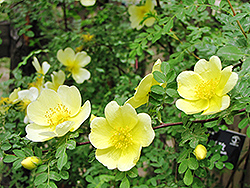Fri & Sat 8am - 8pm
Sun 8am - 7pm
Anytown, USA 12345
fax: 261.787.0463
e-mail: info@successgc.com


Plant Finder

Height: 10 feet
Spread: 10 feet
Sunlight:
![]()
Hardiness Zone: 4b
Description:
A graceful shrub with arching canes smothered in bright yellow flowers in mid spring; upright, spreading habit; resistant to disease, a good background shrub for the sunny border; needs full sun and well-drained soil
Ornamental Features
Manchu Rose features showy yellow flowers at the ends of the branches from early to mid spring. The flowers are excellent for cutting. It has dark green deciduous foliage. The small oval compound leaves turn yellow in fall. The fruits are showy red hips displayed from late summer to late fall. The spiny red bark adds an interesting dimension to the landscape.
Landscape Attributes
Manchu Rose is a multi-stemmed deciduous shrub with a more or less rounded form. Its average texture blends into the landscape, but can be balanced by one or two finer or coarser trees or shrubs for an effective composition.
This is a high maintenance shrub that will require regular care and upkeep, and is best pruned in late winter once the threat of extreme cold has passed. It is a good choice for attracting bees to your yard. Gardeners should be aware of the following characteristic(s) that may warrant special consideration;
- Disease
- Spiny
Manchu Rose is recommended for the following landscape applications;
- Accent
- Mass Planting
- Hedges/Screening
- General Garden Use
Planting & Growing
Manchu Rose will grow to be about 10 feet tall at maturity, with a spread of 10 feet. It tends to be a little leggy, with a typical clearance of 2 feet from the ground, and is suitable for planting under power lines. It grows at a medium rate, and under ideal conditions can be expected to live for approximately 30 years.
This shrub should only be grown in full sunlight. It does best in average to evenly moist conditions, but will not tolerate standing water. It is not particular as to soil type or pH. It is somewhat tolerant of urban pollution. This species is not originally from North America.
